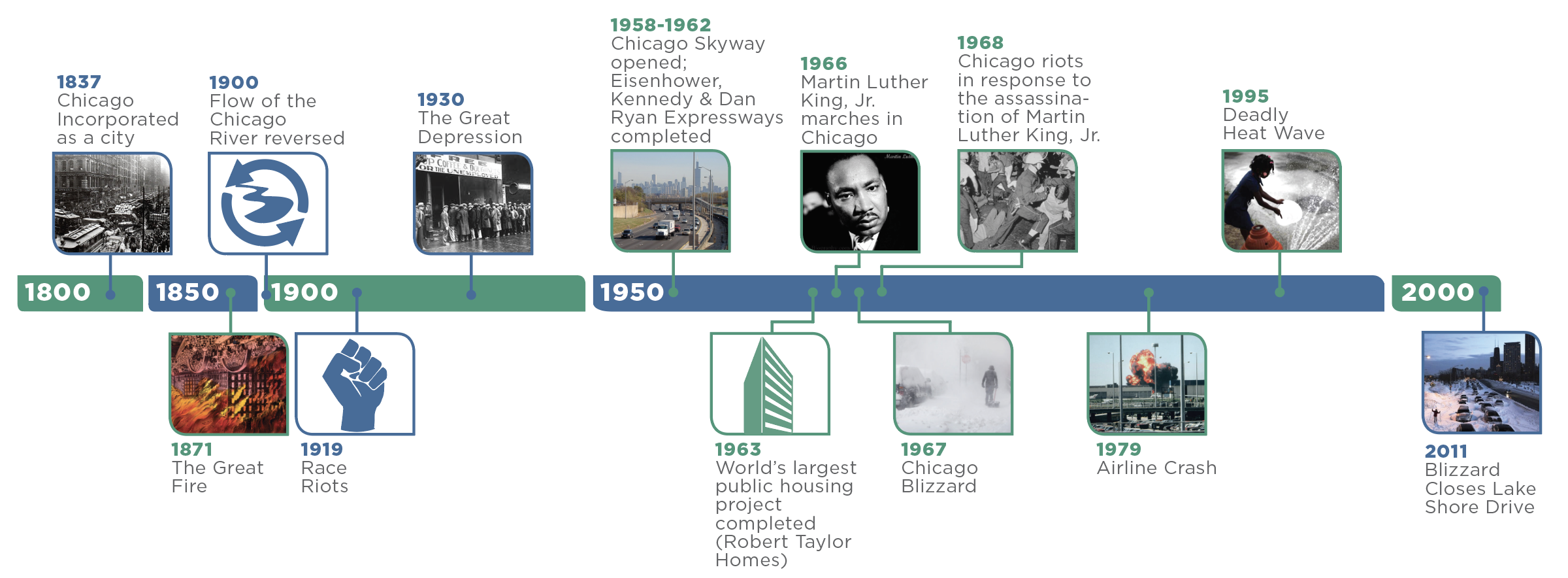Roots Of Chicago’s Resilience
Chicago is one of the most diverse, creative, and innovative cities in the United States. Located in the heart of the Midwest, it has long been a connector between the nation’s two coasts. As a major city in such a critical location, it is also home to one of the most prosperous economic centers in the country. Chicago’s resilience is deeply rooted in its history – be it through surviving a combination of natural and manmade shocks and stresses or proactively implementing initiatives to improve future responses and strengthen neighborhoods and communities.
Chicago In Context
- 2.7 million residents from over 140 countries with more than 100 languages spoken
- 77 community areas and more than 200 neighborhoods
- 130 colleges and universities with 118,000 annual graduates
- 39 percent of residents 25 years or older hold a Bachelor’s degree or higher
- Record-high graduation, college acceptance, and college scholarship rates for Chicago Public Schools in 2018
- Nearly 1 billion gallons of clean water drawn from Lake Michigan every day
- More than 600 parks and 8,800 acres of public green space
- Hundreds of cultural institutions and museums
- Six of the nation’s seven Class I North American railroads
- Six major U.S. interstates
- Two of the world’s busiest airports
- Named Best Bike City in America by Bicycling Magazine in 2016
Significant Resilience Events in Chicago’s History

The Great Fire of 1871 caused tremendous devastation that could have led to Chicago’s decline, but instead was taken as an opportunity to reimagine the city skyline and streets. Fewer than 30 years later, this renaissance continued from land to water, with the reversal of the Chicago River to protect Lake Michigan, the city’s drinking water supply. Blizzards such as those in 1967 and 2011 have led to advanced technologies and snow removal strategies that enable the city to anticipate and more efficiently respond to similar events in the future. The 1995 heat wave resulted in the tragic loss of over 700 lives. The devastating impact underscored the vital need for community resilience and ultimately led residents, community groups, institutions, and government to collectively develop community-based strategies to prepare vulnerable residents for future extreme events.
The era of urban renewal of the mid-20th century that sought to revitalize the city through large scale infrastructure investments – including the expansion of the city’s expressway system – precipitated the mass displacement of residents from their communities and exacerbated the disconnect between neighborhoods. The city has sought to reverse the legacy of these policies through strategic neighborhood investments, affordable housing initiatives, and the reconnection of residents and communities. Though the city has successfully implemented strategies to overcome challenges it has faced, many Chicago neighborhoods still grapple with significant hardship due to a history of neglect, disconnection, and discrimination. The consequences of redlining, the creation of and subsequent disregard for housing projects, and the unequal distribution of city resources linger to this day. Demographic shifts, declining populations, and lack of investment are only a few examples of the effects of this history, disproportionately experienced by the city’s most vulnerable residents. Moreover, the city faces new challenges such as a changing climate and economy, which must be addressed in ways that build resilience for the future. Resilient Chicago was developed to meet these needs.
